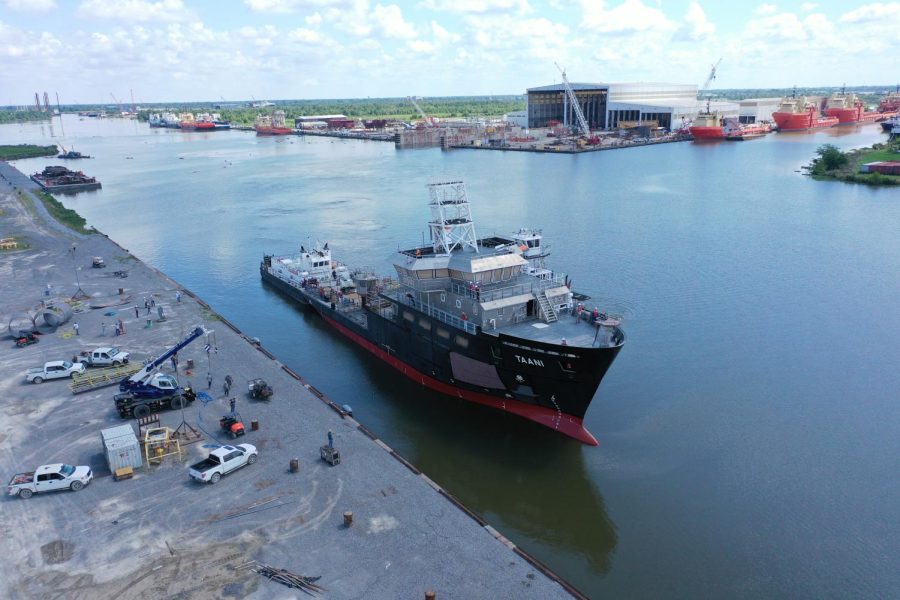Newport’s soon-to-be resident takes its first steps in Louisiana
The R/V Taani research vessel to arrive in 2025 to conduct research expeditions under OSU
July 3, 2023
While scientists say the Arctic Ocean could be ice-free within the next decade – according to a 2023 Nature Communications study – Oregon State University has just been given another tool to research ocean science and climate change.
Its name is R/V Taani, and it is one result of $390 million in grants from the United States National Science Foundation and over a decade of work from OSU faculty and professional staff.
Bollinger Shipyards, where it is being built, acquired the contract for construction in 2021, according to Clare Reimers, Regional Class Research Vessel project scientist and OSU distinguished professor.
Taani became the first of three new oceanographic vessels conducting research in U.S. waters when launched in late May by Bollinger Shipyards from a LaShip drydock facility in Louisiana, according to Reimers.
The vessel is being built as a part of the RCRV project which is to deliver three total research vessels to the U.S. Academic Research Fleet.
According to Reimers, while the ship is not yet complete, its major exterior, the hull and superstructure, are already constructed.
“The launch of the first RCRV, R/V Taani, is an exciting moment for the oceanographic research enterprise,” said Jim McManus, division director for the NSF’s Division of Ocean Sciences, in the press release. “It is fantastic to see this elegant new ship in the water, and we are eager to see the ground-breaking science that will be forthcoming.”
Chosen to recognize Oregon’s Indigenous peoples, Taani’s name can be translated as “off shore” from the Siletz tribal language.
“Seeing Taani in the water is a very special moment and signifies the promise of many scientific advances to come in the years ahead,” said Tuba Özkan-Haller, dean of OSU’s College of Earth, Ocean, and Atmospheric Sciences, in the press release. “We are grateful that the National Science Foundation has entrusted us to lead this project.”
The two other RCRV project vessels will both stay on the East Coast and Gulf Coast, which makes Taani the lone vessel from the project on the West Coast.
One vessel, Narragansett Dawn, will be operated by the East Coast Oceanographic Consortium led by the University of Rhode Island and the other, Gilbert R. Mason, will be based in the Gulf of Mexico, according to Reimers.
The latter will be under management by the Gulf-Caribbean Oceanographic Consortium, led by the Louisiana Universities Marine Consortium and the University of Southern Mississippi.
According to Reimers, operations for the vessels will depend on the science and could change from year to year, even extending to other regions such as off Alaska.
The ships, approximately 200-feet, are planned to be nearly identical, with “new technologies and other features to enhance operational capabilities, improve safety and expand ocean-based research,” according to the press release.
According to Reimers, each ship is designed to operate with up to 33 individuals who are either part of the crew, or are scientists; missions can be up to three weeks at sea.
Construction of Taani is expected to be completed in 2024 despite the original plan for the project planning for 2023. Various delays from different factors, including COVID-19 to multiple Gulf Coast hurricanes, prevented construction from staying on timeline, according to the press release.
After its completion, the Taani and its new OSU-based crew is set to spend several months familiarizing themselves with the vessel in the Gulf of Mexico before bringing Taani through the Panama Canal to its home port in Newport, Oregon, the press release said.
The first research expeditions aboard Taani are expected to start in 2025, according to the press release.
Alongside the Taani’s construction, the Hatfield Marine Science Center in Newport is progressing with its $13 million project to renovate their dock for the vessel, including a new power system and wider trestle.
“The upgrades to the OSU pier will enable the staging of research cruises aboard Taani and the maintenance of the vessel,” Reimers said. “These upgrades should be completed before Taani starts operations from Newport. The pier upgrade is only part of larger plans for the HMSC.”
According to Reimers, some of the critical issues the Taani will study range from understanding the complexities of the coastal ocean to developing strategies for managing coastal resources.
“Many coastal ecosystems are being affected by climate change and other escalating anthropogenic impacts,” Reimers said.
In the short term, Taani is set to remain at the Bollinger Shipyards while construction and outfitting are completed.












































































































